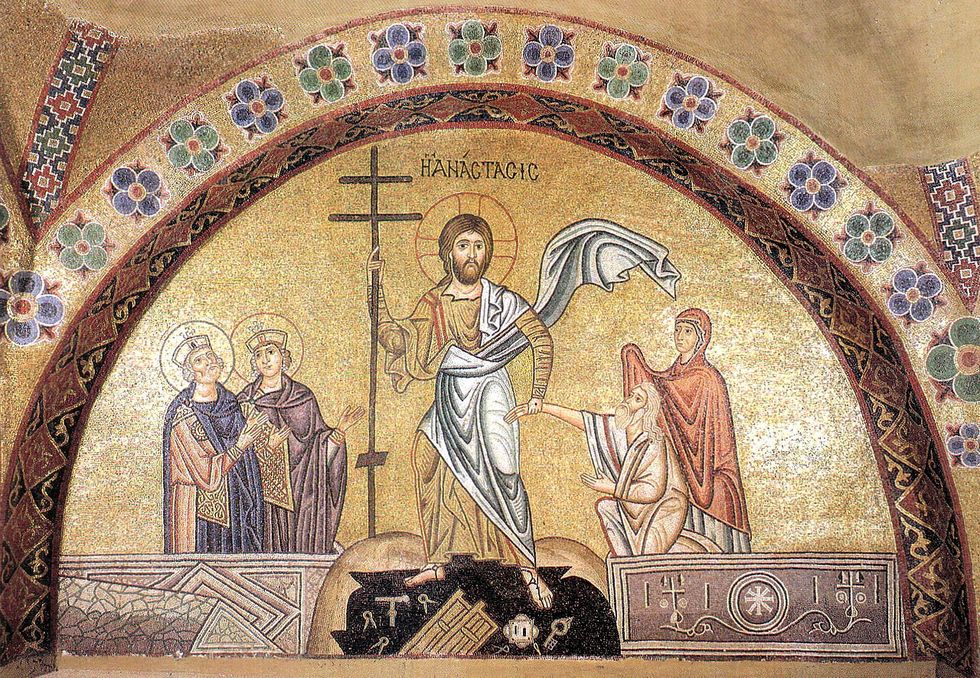Those of us who grew up going to church were taught that Jesus died for our sins. But what precisely does this statement mean? The common teaching in the American Protestant world normally goes along the lines of, “Adam and Eve sinned by eating the fruit of the tree, so God expelled them from paradise and was angry, needing to kill someone for this sin because God is just and the punishment of sin is death. But because God is also merciful, He sent Jesus to die on our behalf and appease the wrath of God the Father so that we don’t have to go to hell.”
I used to believe this teaching and believe so no longer. I do not hold to that view of Jesus’ death anymore because neither the Holy Scriptures nor the early Christians held that view. Rather than focusing on God’s anger and justice, the earliest Christians focused on God becoming Man in the person of Jesus Christ out of His love for humanity. He does this in order to destroy death through His own death and resurrection and grant resurrection to all. St. Paul clearly teaches this in his first epistle to the Corinthians:
20 But now Christ is risen from the dead, and has become the firstfruits of those who have fallen asleep. 21 For since by man came death, by Man also came the resurrection of the dead. 22 For as in Adam all die, even so in Christ all shall be made alive. 23 But each one in his own order: Christ the firstfruits, afterward those who are Christ’s at His coming. 24 Then comes the end, when He delivers the kingdom to God the Father, when He puts an end to all rule and all authority and power. 25 For He must reign till He has put all enemies under His feet. 26 The last enemy that will be destroyed is death. 27 For “He has put all things under His feet.” (1 Corinthians 15:20-27)
By stating that death is the last enemy that will be destroyed is death, St. Paul clearly puts the emphasis on Jesus destroying death by His own death, vanquishing all of our enemies in the process. One of the earliest Christian hymns about the resurrection also teaches this:
Christ is risen from the dead, trampling down death by death, and to those in the tombs, granting life.
Or, in the original Greek:
Χριστός ανέστη εκ νεκρών, θανάτω θάνατον πατήσας, και τοις εν τοις μνήμασι ζωήν χαρισάμενος.
Understanding a little of the Greek is important in order to grasp the original meaning. The first word translated death is the word νεκρών (nekron), which refers to some instance or instances of physical death. In this case, it is Christ’s death on the cross. The second use of death is the word θάνατον (thanaton), which means the abstract concept of death. The hymn is stating that through Christ’s rising εκ νεκρών (from those who are physically dead), He has trampled down upon θάνατον (the existence of death itself).
The early Christians believed that Christ destroyed death so that that we may live forever; that is, Jesus grants resurrection and redemption to humanity through the cross. This is precisely how the fourth century bishop Athanasius describes the Christian concept of salvation in a letter he wrote titled On the Incarnation:
…for the first fact that you must grasp is this: the renewal of creation has been wrought by the Self-same Word* Who made it in the beginning. There is thus no inconsistency between creation and salvation for the One Father has employed the same Agent for both works, effecting the salvation of the world through the same Word Who made it in the beginning.
*[Note that “Word” refers to Jesus Christ. The Gospel of St. John also refers to Christ as the Word.]
This is the way in which the Orthodox Christian Church, of which I am a part, understands salvation. Mankind fell and cut itself off from God, Who Himself is the source of life. This brought death into the world. And God, out of His love for man, became human in order raise us up, destroyed death by His own death, and granted resurrection to the world. And this God, our Lord Jesus Christ, is the One who renews all things, saying, “Behold, I make all things new.” (Revelation 21:5). This teaching has been the teaching of the Church for over 2,000 years; views of an angry God needing to kill His Son were later inventions of Roman Catholic and Protestant theologians.
A few months ago, I met a fellow brother in Christ named Dan Bein at an Orthodox retreat I was at through OCF (Orthodox Christian Fellowship). While talking about how to share the gospel with others, he summarized the gospel, saying, “God loves you, and Christ is risen.” This is the gospel that I believe in and invite you to likewise partake in.
If you would like a more complete explanation of how Christ destroyed death and what that means for humanity, I would recommend reading the entirety of On the Incarnation , which you can find by clicking here.






















